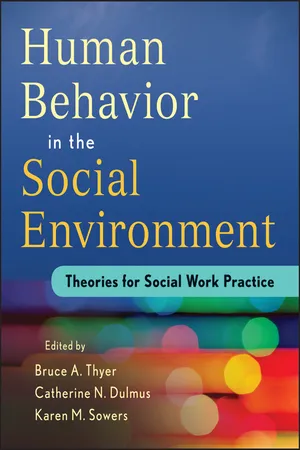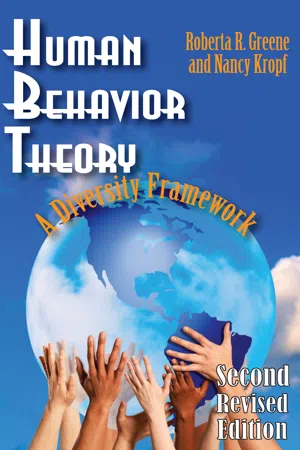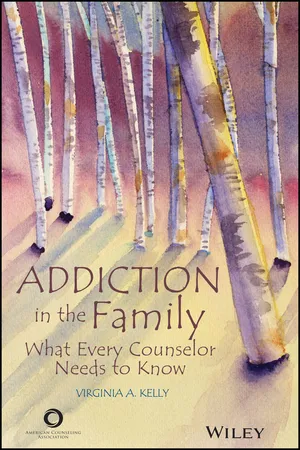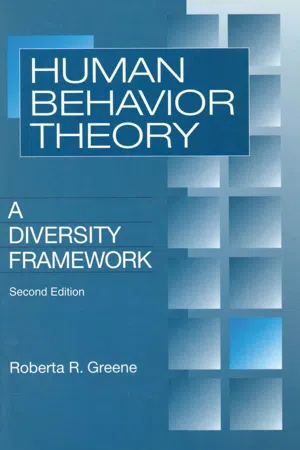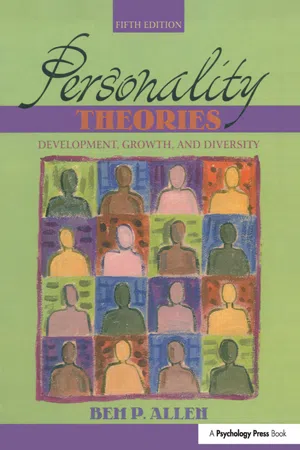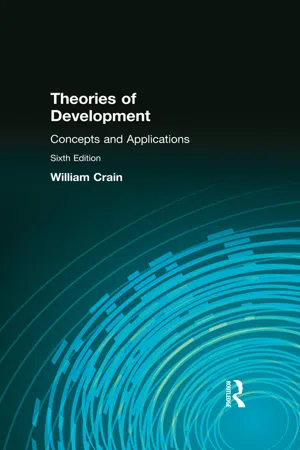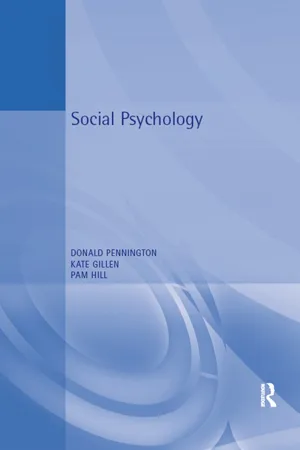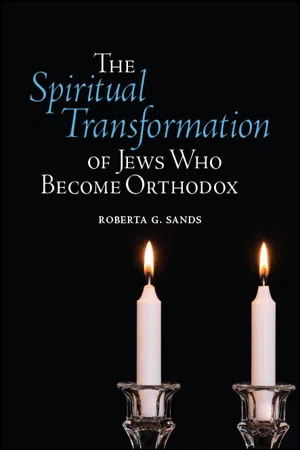Psychology
Erikson's Psychosocial Stages of Development
Erikson's Psychosocial Stages of Development are a series of eight stages that individuals go through from infancy to old age. Each stage is characterized by a specific psychosocial crisis that must be resolved for healthy development to occur. These stages encompass the challenges and conflicts individuals face as they navigate through different life phases, ultimately shaping their personality and identity.
Written by Perlego with AI-assistance
Related key terms
11 Key excerpts on "Erikson's Psychosocial Stages of Development"
- eBook - ePub
Human Behavior in the Social Environment
Theories for Social Work Practice
- Bruce A. Thyer, Catherine N. Dulmus, Karen M. Sowers(Authors)
- 2012(Publication Date)
- Wiley(Publisher)
1. Describe how Erikson's conceptualization of human development significantly differs from that of Freud.2. Consider the so-called core pathologies depicted in Table 6.6 , and discuss whether you judge these to be essential and common reactions that give rise to difficulties.3. To what extent does the “stage model” advocated by Erikson take into account cultural and temporal differences? Is the emergence and sequence of these patterns affected by the differences across decades, countries, cultures, or racial groups?4. Seek out a recently published empirical outcome study that involved an intervention derived from Erikson's psychosocial theory (e.g., the therapeutic value of a Life Review). Critically analyze this investigation, in terms of the effectiveness of this intervention.Online Resources
http://video.google.com/videoplay?docid=-7953598721199398444A YouTube clip using archival materials and newly shot footage, this film introduces students to the rich wisdom of Erik H. Erikson, best known for his identification of the eight stages of the life cycle. This film combines biographical information about Erikson with his theoretical proposals to give students an understanding of the relationship between the life experience of a theorist and the work that is produced.www.erikson.edu/default/aboutei/history/erikerikson.aspxThis is a link to the Erikson Institute, an independent institution of higher education founded in 1966 that prepares child development professionals for leadership. Through its academic programs, applied research, and community service and engagement, the institute advances the ability of practitioners, researchers, and decision makers to improve life for children and their families. - eBook - ePub
- Sarah J. Shin(Author)
- 2016(Publication Date)
- Multilingual Matters(Publisher)
I first review Erik Erikson’s (1963) theory of psychosocial development, which has become the basis for many subsequent studies on aging. Erikson was one of the first scholars to chart the sequence of life stages from birth to death and to describe adult development as an opportunity for growth rather than an inevitable decline in physical and mental capacity. He was also among the first developmental psychologists to recognize that human learning and identities are not developed in a vacuum but are shaped by the cultural and historical settings in which people live. He argued that people born during different historical periods will have different world views, and the experiences of one generation may not be the same as those of another. Despite the groundbreaking nature of his work, however, Erikson gave only limited attention to older age. I discuss how the study of adulthood has further developed through the contributions of contemporary scholars such as Gail Sheehy, Mary Catherine Bateson and Gene Cohen, and how human development is increasingly viewed as a lifelong process. I describe the defining features of later adulthood by way of the experiences and perceptions of the participants in my study and show how they are deriving personal fulfillment through their work with people who are learning English as a second language.Erikson’s Eight Stages of Psychosocial DevelopmentErikson (1963) outlined eight stages of psychosocial development across the human lifespan and characterized each stage in terms of an issue or crisis that must be resolved (see Table 2.1 ). He argued that the way in which each developmental crisis is resolved will determine whether the individual will experience happiness or discontent, and that each stage builds on the successful resolution of challenges faced by the individual in preceding stages. In Erikson’s Stage 1, newborn babies are utterly dependent on their parents or caregivers to provide for their most basic needs - food, comfort and affection. If infants receive consistent and responsive care, they will develop a sense of trust, which they will carry to other relationships in the future. But if the care is inconsistent or harsh, they will develop a sense of mistrust, anxiety and insecurity. Erikson argued that success in Stage 1 leads to the virtue (or strength) of hope. By developing trust, infants can hope that as new crises arise in the future, they can count on the support of other people.Table 2.1 Erikson’s eight stages of psychosocial developmentStage Psychosocial crisis Basic virtue 1. Infancy Basic trust vs. basic mistrust Hope 2. Early childhood Autonomy vs. shame, doubt Will 3. Play age Initiative vs. guilt Purpose 4. School age Industry vs. inferiority - eBook - ePub
Human Behavior Theory
A Diversity Framework
- Roberta R. Greene, Nancy Kropf(Authors)
- 2017(Publication Date)
- Routledge(Publisher)
Erikson’s (1959) most important and best known contribution to personality theory is his model of eight stages of ego development. In this life cycle approach, he proposed that development is determined by shifts in instinctual or biological energy, occurs in stages, and centers around a series of eight psychosocial crises. As each stage emerges, a psychosocial crisis fosters change within the person and in his or her expanding interconnections between self and environment. Crises offer the opportunity for new experiences and demand a “radical change in perspective” or a new orientation toward oneself and the world (Erikson, 1963, p. 212). The result is an “ever-new configuration that is the growing personality” (Erikson, 1959, p. 57).Erikson emphasized that one stage of development builds on the successes of previous stages. Difficulties in resolving earlier psychosocial issues may foreshadow further difficulties in later stages. Each stage of development is distinguished by particular characteristics that differentiate it from preceding and succeeding stages (Newman & Newman, 2005). The notion that development occurs in unique stages, each building on the previous one and having its own emphasis or underlying structural organization, is called stage theory (see Figure 4.1 ). Erikson argued that personality is a function of the outcome of each life stage. The psychological outcome of a crisis is a blend of ego qualities resting between two contradictory extremes or polarities. This means an individual’s personality reflects a blend of ego qualities such as trust or mistrust.Social workers and other human services professionals refer to several theories of personality development that are based upon assumptions of sequential, universal stages. In addition to Erikson, other well-known stage theorists include Sigmund Freud, Heinz Hartmann, Margaret Mahler, Jean Piaget, and Lawrence Kohlberg (Germain, 1991). Although stage theories continue to be used by practitioners, their utility and universality are increasingly being questioned.As stated in Chapter 3 - eBook - ePub
Adult Personality Development
Volume 1: Theories and Concepts
- Lawrence S. Wrightsman(Author)
- 1994(Publication Date)
- SAGE Publications, Inc(Publisher)
4
Erikson’s Theoryof Psychosocial Development
Anything that grows has a ground plan, and out of this ground plan the parts arise, each part having its time of special ascendancy, until all parts have risen to form a functioning whole.Erik H. EriksonThat type of approach that sees personality developing through a series of stages dominates this and the next three chapters. After evaluating Erik Erikson’s conception in this chapter, we examine in Chapter 5 the utility of psychobiography as an explanation of personality, and in Chapters 6 and 7 other major explanations that rely on psychosocial stages. Although different stage theorists highlight different qualities, they possess a similarity in basic perspective. In general these conceptions view each stage or period as qualitatively different, with relatively abrupt shifts from stage to stage. Each of these stages is assumed to build on the earlier ones, and a successful reaction to the crisis or major task of each stage, in effect, gives the person the capabilities necessary to attack the conflicts of the next stages. Thus each new stage provides a wholly new level of structural integration. But an unsuccessful or inadequate resolution of one “crisis” hinders the growth preferred at each subsequent stage unless some special intervention occurs (Dacey, 1982).Erikson’s Backgroundand Intellectual Development
Erik Erikson’s life is so illustrative of Chapter 3 ’s conclusion that theorists’ concepts derive from their own experiences, it is worth detailed review.Erikson’s Life
The man who is now named Erik Homburger Erikson was born in 1902 in Frankfurt, Germany. He grew up in Karlsruhe, in southern Germany, as the son of a pediatrician, Dr. Theodor Homburger, and his wife, Karla, formerly named Abrahamsen. Erikson’s mother was a native of Copenhagen, Denmark. The circumstances of Erikson’s birth are not clear; Wright (1982) states that Erikson’s Danish father abandoned his mother. Elkind (1982) notes that “not long after his birth his [real] father died” (p. 14). But this may be a rather sanitized version; Erikson has been reluctant to reveal the facts of his early life. Only when he was in his seventies did he state the following: “All through my earlier childhood, they kept secret the fact that my mother had been married previously, and that I was the son of a Dane who had abandoned her before my birth” (Erikson, 1975, p. 27). - eBook - ePub
Addiction in the Family
What Every Counselor Needs to Know
- Virginia A. Kelly(Author)
- 2015(Publication Date)
- American Counseling Association(Publisher)
In fact, the most well-researched population of individuals who live with a substance-abusing family member are children of substance abusers. In particular, substantial attention has been given to the population of children of alcoholics (COAs). Of course, COAs constitute a diverse population of individuals with varying circumstances that affect their response to parental substance abuse. However, despite the unique circumstances for individuals raised by a parent with an SUD, the consensus in the field of substance abuse and addictions is that this population of individuals struggles with a number of identified issues at a significantly higher rate than individuals who are not raised by substance-abusing parents. In fact, this conclusion has been empirically tested over a number of years, and the literature supports this assumption (Klostermann et al., 2011; Menees & Segrin, 2000; Sher, Walitzer, Wood, & Brent, 1991). These issues span all facets of an individual's life and include psychiatric diagnoses that occur at higher rates for COAs as well as feelings, thoughts, and behaviors that affect development throughout the life span. It is therefore critical to synthesize our foundational understanding of how human development is affected when the family environment is organized around an SUD.Many theories of development have been proposed and studied, and all of them provide important perspectives. However, it is not feasible to present all of these perspectives in this book. Therefore, in this book I limit the exploration and application of developmental perspectives to psychosocial development, as this is perhaps the area of development that counselors are most likely to explore with clients. In this chapter I provide a brief overview of Eric Erikson's theory of psychosocial development (1950), as it is a widely accepted psychosocial model for conceptualizing client cases. In addition, Erikson's theory links seamlessly to the kinds of issues that might present in working with clients dealing with the issue of familial substance abuse.Erik Erikson is credited with the development of a psychosocial theory built on the work of Sigmund Freud (1930/2010). Erikson asserted that Freud emphasized particular aspects of development while avoiding others (Erikson, 1950), and Erikson developed a theory that he felt provided a more balanced view of the psychosocial development of individuals. In addition, Erikson expanded the notion of development, continuing it into later stages and proposing a life span perspective. As professional counselors, we endorse a life span perspective; thus, Erikson's theory has played a large role in our professional understanding of human development.Erikson proposed eight stages of development. He characterized each of these stages with a specific crisis. However, he did not see the developmental crisis as a catastrophe or negative experience. Instead, he proposed a continuum of two opposing outcomes for each developmental stage. The identified crisis represents what Erikson saw as the central theme or life task typical of individuals within that developmental stage. Furthermore, he suggested that optimal development within a particular stage would result in a resolution of the identified crisis that was positive (i.e., at one end of the continuum). Poor resolution of the crisis would result in a negative outcome (i.e., the other end of the continuum). In reality, individuals will resolve each developmental crisis with a greater or lesser degree of success in terms of overall psychosocial development. As counselors, we can benefit greatly by assessing the developmental histories of our clients. To be specific, we can put present-day issues into context when we understand what may have transpired for a client during critical developmental periods. - eBook - ePub
Human Behavior Theory
A Diversity Framework
- Roberta Greene(Author)
- 2017(Publication Date)
- Routledge(Publisher)
He cautioned that practitioners can misconstrue closeness between family members, particularly mother and child, among many Latinos or Asian-American families. Similarly, among many minority adolescents, autonomy is not determined solely by moving out of the home. Rather, it is expected that family members will continue to live in extended households. Critique of Life Stage Models of Development Erikson’s (1959) most important and best known contribution to personality theory is his model of eight stages of ego development. In this life cycle approach, he proposed that development is determined by shifts in instinctual or biological energy, occurs in stages, and centers around a series of eight psychosocial crises. As each stage emerges, a psychosocial crisis fosters change within the person and in his or her expanding interconnections between self and environment. Crises offer the opportunity for new experiences and demand a “radical change in perspective,” or a new orientation toward oneself and the world (Erikson, 1963, p. 212). The result is an “ever-new configuration that is the growing personality” (Erikson, 1959, p. 57). Erikson emphasized that one stage of development builds on the successes of previous stages. Difficulties in resolving earlier psychosocial issues may foreshadow further difficulties in later stages. Each stage of development is distinguished by particular characteristics that differentiate it from preceding and succeeding stages (Newman and Newman, 1987). The notion that development occurs in unique stages, each building on the previous one and having its own emphasis or underlying structural organization, is called stage theory (Figure 5.1). Erikson argued that personality is a function of the outcome of each life stage. The psychological outcome of a crisis is a blend of ego qualities resting between two contradictory extremes or polarities - eBook - ePub
Personality Theories
Development, Growth, and Diversity
- Bem P. Allen(Author)
- 2015(Publication Date)
- Psychology Press(Publisher)
The “tasks of life” theme is at the heart of Erikson’s theory. At each succeeding stage of human development people have new tasks to master. Thus, life and its challenges are constantly evolving. Contrary to the way Freud thought of it, or even the way Allport conceived of it, maturity to Erikson is not something most people achieve or not. Instead, it is something that people approximate well or not so well.How well people conquer the tasks of a given stage determines toward which of two poles they migrate, one representing positive development and the other negative development. The poles symbolize the horns of a dilemma. Parents, the individual’s society, interactions with peers, and the individual’s own skills determine how well the dilemma is resolved. In turn, resolution promotes the development of a new strength, a virtue arising from dominant movement toward the positive pole. With resolution comes the ability to face the challenges of the next stage.Basic Concepts: Erikson
Erikson believed that people go through eight stages of psychosocial evolution that is termed psychosocial development, a union of physical yearnings and the cultural forces that act on the individual (“Erik Erikson,” 1970). These phases include four childhood stages, one adolescent stage, and three adult stages. They are characterized by epigenesis (epi means “upon” and genesis means “emergence”): the stages literally emerge “one on top of another in space and time” (quoted in Evans, 1976, p. 294). Each is built on the other like each upper-level math course is built on lower-level courses. His most basic concepts are tied to the eight stages.Like Jung, Erikson advocated a reality in which thesis and antithesis, the conflict of opposites, yielded synthesis, the resolution of conflict. Maturity and contentment result from synthesis; stagnation and maladjustment follow failure to resolve conflicts. The conflict at each stage is termed a “crisis.” In effect, at each stage, the crisis that the individual experiences entails being stretched between the opposing positive and negative poles associated with the stage. Successful resolution of a crisis prepares the person for the next step in the quest for identity. As may have occurred to you, the popular phrase “identity crisis” originates in Erikson’s conception of the psychosocial crises. - eBook - ePub
Psychology for Actors
Theories and Practices for the Acting Process
- Kevin Page(Author)
- 2018(Publication Date)
- Routledge(Publisher)
While many have grouped him with the neo-Freudians, Erikson himself preferred the more neutral title of post-Freudian (Frager & Fadiman, 2005, p. 175). As with many of the early psychoanalysts who followed Freud, Erikson both accepted and criticized Freud’s theories, and ultimately expanded them into areas far beyond Freud’s original limited vision. Erikson’s three major innovations to Freud’s theories included the idea that along with stages of psychosexual development, individuals also go through simultaneous psychosocial and ego-development stages; personality development continues throughout a person’s life span, and is not wholly fixed after early childhood; and that each stage of development can have either a positive (healthy) or negative (neurotic) outcome that affects all following stages. In Erikson’s model, each stage of development culminates in a crisis between two potential extremes that must be successfully solved in order to move on to the next stage. In solving this developmental crisis, the individual gains a particular competence or virtue that is useful (in its healthy versions) during all later stages of growth. In addition to his life span developmental model, Erikson introduced the notions of identity and identity crisis into psychology and other social sciences. Identity, for Erikson, was a broad and inclusive term that included the ego as a central agency or organizing principle for the personality, the sense of individuality and continuity of experience, as well as the process of identifying and internalizing the rules and ideals of social groups with which the individual might be affiliated. An identity crisis is a mental state where the individual, even if only on a temporary basis, has lost or is in between a solid sense of identity and appropriate social affiliation. Erikson first identified these concepts when working with World War II veterans in a rehabilitation clinic in San Francisco - eBook - ePub
Theories of Development
Concepts and Applications
- William Crain(Author)
- 2015(Publication Date)
- Routledge(Publisher)
CHAPTER 12Erikson and the Eight Stages of Life
BIOGRAPHICAL INTRODUCTION
Among the advances in the psychoanalytic theory of development, none has been more substantial than that made by Erik H. Erikson (1902–1994). Erikson has given us a new, enlarged picture of the child’s tasks at each of Freud’s stages. Beyond this, he has added three new stages—those of the adult years—so the theory now encompasses the entire life cycle.Erikson was born to Danish parents in Frankfurt, Germany, the child of an extramarital union he and his mother kept secret (“Erik Erikson,” 1994). Erikson was raised by his mother alone until he was 3 years old, when she married again, this time to a local pediatrician, Dr. Homburger. His mother and Dr. Homburger were Jewish, but Erikson looked different—more like a tall, blond, blue-eyed Dane. He was even nicknamed “the goy” (non-Jew) by the Jewish boys (Coles, 1970, p. 180).Young Erikson was not a particularly good student. Although he excelled in certain subjects—especially ancient history and art—he disliked the formal school atmosphere. When he graduated from high school, he felt lost and uncertain about his future place in life. Instead of going to college, he wandered throughout Europe for a year, returned home to study art for a while, and then set out on his travels once again. He was going through what he would later call a moratorium , a period during which young people take time out to try to find themselves. Such behavior was acceptable for many German youth at the time. As Erikson’s biographer, Robert Coles (1970), says, Erikson “was not seen by his family or friends as odd or ‘sick,’ but as a wandering artist who was trying to come to grips with himself” (p. 15).Erikson finally began to find his calling when, at the age of 25, he accepted an invitation to teach children in a new Viennese school founded by Anna Freud and Dorothy Burlingham. When Erikson wasn’t teaching, he studied child psychoanalysis with Anna Freud and others, and he was himself analyzed by her. - eBook - ePub
- Richard Gross, Rob McIlveen(Authors)
- 2016(Publication Date)
- Routledge(Publisher)
Generality versus stagnationAdult willing to care for children and others and work for the common good; or becomes self-centred and stagnates8 Old ageIntegrity versus despairOlder person reflects on meaningfulness of life and accepts own mortality; or despairs over past failuresTable 2.3: Erikson’s stages of psychosocial development. At each stage a new psychological crisis must be resolvedAdolescence is generally the time for establishing one’s own identity and reflects the growing child’s need to see itself as separate from and different to its caregivers. At Erikson’s fifth stage, identity vs. identity diffusion, the adolescent must achieve a coherent self-identity, or set of values and beliefs which marks it out as a unique individual. Failure to do this will result in role confusion and a diffusion of identity. Erikson’s final three stages concern the developmental work of adulthood and old age. Stage six concerns the struggle to achieve intimacy, by learning to give enough of yourself to another person to facilitate a loving and enduring relationship or series of relationships. The ego strength associated with this stage is love, and if this is not achieved, social isolation will result. In middle age, Erikson identifies the psychological crisis as generativity versus stagnation. At this stage adults become willing to help others without the expectation of reward. They also become committed to their work and to the common good, and the ego strength associated with this stage is care for others. Unsuccessful negotiation of this stage results in stagnation, with self-centred behaviour and inactivity becoming the norm. The final stage in Erikson’s model concerns old age, which may be taken to mean the age at which most people in the West retire from their permanent job. At this stage the crisis is between integrity and despair - Roberta G. Sands(Author)
- 2019(Publication Date)
- SUNY Press(Publisher)
Erikson’s theory encompasses the entire life span, with individuals facing developmental crises at certain normative ages. These stages can be revisited later on when, for example, individuals reconstruct their Jewish identities—in this case, their spiritual identities—when they become Orthodox. Arnett gives particular attention to the period he calls “emerging adulthood,” in the twenties or earlier. Levinson’s “seasons” of a person’s life describe changes in life structure that characterize each decade, with transitional periods in between. Baalei teshuvah’s religious/spiritual change—whether it occurs in late adolescence or emerging, young or middle adulthood—constitutes in change in life structure. It is continuous with their Jewish ethnicity, but for some it may be radically different from their Minimalist or Mainstream upbringing, and for those who were previously Reform, Conservative, or Reconstructionist, it is more intense and demanding than their prior religious orientation. At the time of their interviews, interviewees were in a different place than they were when they committed to Orthodox Judaism. Most were married and had children, and all had a religious community. They had settled down or were reorganizing their lives in relation to a spouse, family, work, and religion. Their psychosocial development was within or close to the positive poles within Erikson’s developmental theory, with women having a higher level of development than men. Still, they were to face new life changes as they integrated into pre-existing Orthodox communities. The next five chapters deal with challenges occurring post-commitment.
